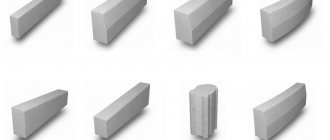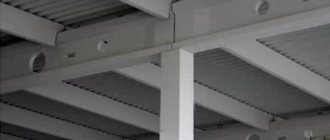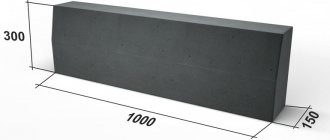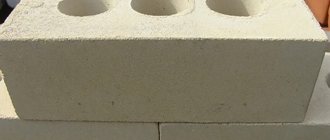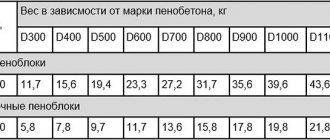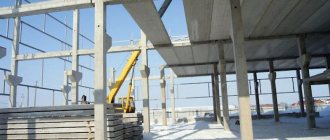Types and purpose of standard blocks
A sidewalk curb is one of the types of reinforced concrete products that are installed on sidewalk blind areas. It should be noted that there are 4 categories of products on sale:
- Curb . This is the most common type of stone used to delimit lawns, pedestrian areas and bicycle paths.
- Vibro-cast curbs . Such products immediately attract attention with their unusual shape and colors. Products can be produced in the form of steps, waves or arcs. The usual gray color of concrete curbs is changed by the addition of dyes and plasticizers. Vibrolithium stones are commonly used as architectural decorations.
- Lawn blocks . This is a type of curb that usually borders lawns to prevent the topsoil from spreading.
- Road stone . This variety can be considered a sidewalk curb at a stretch. They are used to preserve the integrity of the road surface, so the products have massive dimensions and reinforcement is required during manufacturing.
The technology for the production of sidewalk curbs involves the use of heavy concrete grade M 300 or M 500 . This is a prerequisite for the structure to have a high margin of safety and resistance to dynamic compression.
Production
Products are produced using several methods with mandatory sizing. Technologies :
- pouring the liquid mixture into smooth formwork;
- casting using vibration influence;
- simultaneous application of pressing and vibration.
The use of the first two methods is advisable at home or in a small enterprise.
The third method requires expensive special equipment. The composition of the mixture is selected depending on the size of the border. Fine-grained sand and aggregate are used in the manufacture of long elements (more than 1 m). To strengthen the stones, they are supplied with reinforcement.
A detailed article on creating borders is here.
Standard sizes according to GOST
Sidewalk curbs are manufactured in accordance with GOST , therefore they have standard sizes, regardless of the manufacturer. According to the state standard number 6665-91 , the products have the following dimensions:
Curb.
- Length – 500/1,000 mm.
- Width – 45/50/80 mm.
- Height – 200/210 mm.
Lawn block.
- Length – 500 mm.
- Width – 70 mm.
- Height – 211 mm.
Road block.
- Length – 1,000 mm.
- Width – 300/450 mm.
- Height – 150/180 mm.
Vibro-cast curbs have similar dimensions, but do not have a clear geometry.
| Small border | Large border | Garden border (vibropress) | Road curb (vibropress) | |
| Dimensions, mm | 500*200*45 | 500*200*70 | 1000*200*80 | 1000x300x150 |
| Weight, kg | 8 | 12 | 25 | 100 |
| On a pallet, pcs. | 100 | 100 | 40 | 18 |
| Frost resistance | F200 | F200 | F200 | F200 |
| Cement brand | M500 | M500 | M500 | M500 |
This will be useful to you
To better understand tiles for sidewalks and paths, and confidently navigate their types, shapes and sizes, read this article >>>
What to paint with?
If you want to change the color of gray concrete curbs, you can decorate them with water-based façade paint. Such materials are used for painting facades and other outdoor surfaces.
Construction stores offer special paint for concrete stone. The surface of the fence can be painted with polyurethane-based paint. Such coloring products are resistant to fading and abrasion. You can improve the surface of the curb with a special paint for paving slabs, a road dye that can withstand any temperature changes.
You can learn how to properly install a concrete garden border on your site in the video below.
How much does a bead stone weigh?
Given the wide range of sizes, sidewalk curbs cannot have the same weight (see table above). Here you will also have to divide into groups. It looks like this:
- Curbs and lawn blocks. The weight of the products varies between 18-36 kilograms.
- Road curbs. Here, the mass of products can vary between 95-150 kilograms.
The weight of vibration-cast curbs is difficult to calculate. The products have variable geometry; accordingly, the mass of the stone will also change. If we talk about average values, the weight of the product is about 100-120 kilograms.
History of origin
Scientists of Ancient Rome in 450 BC. e. invented the document “12 Tables”, in which the road was divided into a carriageway and sidewalks, and stone curbs were made between them. The curb helps increase the durability of the road surface and prevents gaps and joints from diverging. In the Middle Ages, curbstones were completely forgotten, but were remembered only in the 18th century, as soon as vehicles on wheels began to travel.
Any building material has its own properties, advantages, and scope of application. Borders are distinguished by different colors, sizes, and the raw materials from which they are made.
Self-installation of sidewalk curbs
The sidewalk curb is easy to install, which is an undeniable advantage of this type of product. It is enough to follow this order of work:
- The territory is marked taking into account the features of the landscape.
- According to the markings made, pegs are driven in and the thread is pulled between them. This will be the level of the top of the curb.
- Then a trench is formed along the entire length of the marked area. The depth is 1/3 from the top point of the stone, the width is 10 centimeters larger than the size of the block.
- The bottom of the trench is compacted to prevent soil subsidence.
- Cement-sand mortar is poured. The recommended ratio of materials is 1:3 for cement and sand respectively. The mixture should have mobility convenient for pouring, but not be too liquid.
- Install the border at the level of the cord. The stones are leveled in height by placing mortar underneath.
- The joints are also filled with mortar, the installed borders are left for 24 hours for the mortar to set.
Then the free space of the trench is filled with soil, which must be thoroughly compacted. At the final stage, the sidewalk is installed.
How is the length of a curb stone determined by markings?
All products are marked with a special designation. The letter marking is deciphered quite simply:
- BR - designation of an ordinary curb;
- BU - a rectangular product with a widening;
- BUP - similar to BU, but the broadening is intermittent;
- BL - abbreviation for products with a tray for water drainage;
- BV - exit version with a beveled side;
- BC - a curved border with a beveled upper part.
[testimonial_view id=”27"]
The length, as well as the width and height of the product are easily determined by its markings. Consider the designation BR100.30.18:
- the number 100 indicates the length expressed in centimeters;
- index 30 – corresponds to a height of 300 mm;
- designation 18 – characterizes the width of the stone, equal to 18 cm.
By marking it is easy to determine the type of product, as well as its dimensions. This allows you to calculate the need for products for landscaping a site of a certain size.
Manufacturing technology
Typically, sidewalk curbs are made in a factory, but the production technology is quite simple, so you can make the blocks yourself. This option is ideal for owners of personal plots who want to diversify the landscape design of a country house.
The technological process begins with the manufacture of a mold for casting. It is immediately necessary to clarify that the form can be purchased ready-made - it is a monolithic structure, convenient for pouring and removing concrete mixture. However, you can make the mold yourself using sheets of plywood or metal.
The block size can be chosen arbitrarily, in accordance with individual preferences. However, the length of the stone should not exceed 2 meters (otherwise the block may break).
Note that for ease of installation, one side of the block should have a slight bevel. This can be achieved by making an appropriate mold or cutting off the excess plume with a machine after the mixture has set.
- To prepare the mixture, you need to prepare a cement-sand mixture (proportion 1:3 ).
The components are mixed until a homogeneous mass is obtained. Then crushed stone is added in a ratio of 3 parts stone to 1 part dry mixture. Add water to the mixture and mix, avoiding the formation of lumps. - After this, the mixture is poured into the prepared mold, having previously lubricated the walls with used machine oil.
If you plan to make a reinforced curb, fill the form halfway, then install the reinforcement and add the rest of the concrete. The surface is leveled with a construction trowel.
- To be able to remove the block, the filled mold must sit in a cool place for 3-4 days . After this, the block is removed and left to dry in the open air for another week. After this period, you can begin installation.
SNiP 35-01-2001 and GOST 6665-91
Interestingly, the document (building codes and regulations), which should help cyclists overcome curbs and easily enter sidewalks, is intended for the design, construction and reconstruction of buildings and structures that are accessible to all groups of people with limited mobility. Here the interests of cyclists coincide with the interests of wheelchair users. And since Russia signed the Declaration of the Rights of Persons with Disabilities, adopted by the General Assembly in 1975, there are articles in the legislation that are useful to us, cyclists.
Quote from the current SNiP 01/35/2001:
3.4 The height of curbs along the edges of pedestrian paths on the site is recommended to be at least 0.05 m. The height of the side stones at the intersection of sidewalks with the roadway, as well as the difference in heights of curbs, side stones along maintained lawns and green areas adjacent to pedestrian traffic routes, should not exceed 0.04 m.
This “SNIP” (building codes and regulations) is included in the international Classification ISO 91.040.01, which provides people with disabilities the opportunity to lead an active lifestyle.
Plastic border - an affordable alternative to stone
This is an excellent solution for decorating personal plots. Such garden borders are usually cheaper than their concrete counterparts, and are much more convenient to install. However, ideal materials do not exist in nature, so plastic borders are also not without their drawbacks, but first things first.
Pros and cons of plastic on the garden path
Advantages:
- A wide range of. In addition to the usual ribbon models, you can find decorative elements on sale, imitation of natural stone, brick, wood and metal.
- Practicality. If the plastic section is damaged, it can be easily replaced. You will have to tinker with concrete sidewalk curbs much longer.
- Long service life. Plastic belongs to the category of durable materials.
- Neutrality to any environment. Plastic products are resistant to sudden temperature changes, are not afraid of humidity, and do not fade in the sun.
- Attractive appearance. Such borders are available in a variety of colors, which opens up almost limitless possibilities for decorating personal plots.
It should be noted that the plastic bends easily, which allows you to create winding paths.
If we talk about shortcomings , the following nuances cause complaints:
- Fragile plastic is susceptible to mechanical damage.
- The material burns well.
- Questionable environmental safety.
Typical dimensions and installation
The width of plastic borders varies between 10-28 centimeters, thickness: 0.5-2 mm.
If we talk about installation features, plastic products are much more convenient than their concrete counterparts. The key difference is that there is no need for preliminary site preparation. A trench is dug along the path or flower bed, about 10 cm . Pointed pegs, which are located at the base of plastic borders, are hammered here.
The sections are fastened together with locking joints. The curb is leveled, then the trench is filled with soil.
5.4. Mandatory organizational and technological rules
1. Cement concrete pavements of compressive strength class VZO and B27.5 are installed on main streets and roads, class VZO and B25 on intra-block roads and driveways.
2. Cast concrete mixture with OK = 16 – 18 cm is delivered to the site in concrete mixer trucks.
3. Cast dispersed-reinforced concrete mixtures, including decorative cast mixtures, are also used for road surfaces for various purposes.
4. The construction of roads paved with cast concrete mixtures includes the following stages: preparatory work; construction of subgrade; shallow drainage device; installation of a sandy underlying layer; installation of curb stones; installation of a technological layer; foundation arrangement; coating device.
5. When constructing a subgrade, layer-by-layer compaction of the soil is carried out. The number of passes of the roller along one track depends on the type of soil, the thickness of the compacted layer, the weight and the main design features of the roller, in order to obtain a given soil compaction coefficient.
6. Some projects provide for the construction of shallow drainages. The technological process for installing shallow drainage consists of the following: digging a trench, constructing a ditch, compacting it, laying pipe filters, connecting them to water intakes, filling the trench with sand and compacting it.
7. The installation of the underlying layer can be done in two ways:
First option: transporting sand by road; leveling the first layer of sand with a grader or bulldozer; installation of rail forms; layer-by-layer leveling and compaction of sand with a profiler and watering.
Second option: transporting sand by road; layer-by-layer leveling of sand with a grader or bulldozer and rolling with watering.
8. Curb stones are installed using a curb paver, most often manually using tools. A 10 cm thick concrete base is laid over the compacted sand layer, on which a curb stone is installed along a cord stretched between metal pins at a height corresponding to the upper edge of the stones. On both sides of the curb stone, a concrete cage 10 cm high is placed in the formwork, then the joints between the installed stones are made.
9. A technological layer of limestone crushed stone of grade no lower than 400 is laid over the sandy underlying layer. The technological compacted layer, 15 cm thick, allows machines and mechanisms to be passed over it to construct the road base.
10. The base of the road is made from factory-made compacted crushed stone mixture or compacted low-cement concrete. In some projects, dispersed reinforced concrete mixtures are used as the base.
11. The construction of coatings from cast concrete mixtures, including dispersed reinforced mixtures, is carried out using equipment for distributing the mixture, leveling the surface and compacting it.
12. The mixture must be distributed and profiled against the longitudinal slope of the road under construction.
13
Particular attention should be paid to the location and design of joints in the concrete pavement
14. Care of concrete should be carried out immediately after laying it using plastic film, waterproof paper, glassine, roofing felt, dornite and other film-forming materials.
15. The technological sequence of work for the construction of sidewalk coverings made of monolithic concrete, including decorative concrete, includes the following stages of work: digging and compacting a trough, installing curb stones, installing an underlying layer, installing a base and covering, cutting expansion joints in the covering.
16. Persons at least 18 years of age who have undergone a medical examination, been trained in safe working methods according to an approved program and have been instructed directly in the workplace are allowed to work on the construction of road surfaces made of monolithic concrete. Knowledge testing is carried out annually by a commission, after which workers are issued certificates.
17. The chief engineer of the construction department and the work contractor are responsible for compliance with safety regulations during the construction of road surfaces made of monolithic concrete.
18. When carrying out work in winter on the construction of road surfaces made of monolithic concrete, the chief engineer of the construction department and the work performer are responsible.
Criterias of choice
The choice of border is determined by the objectives and budget in each individual case. If we are talking about arranging the backyard territory of luxury real estate, it is better to consider the use of granite and vibro-pressed borders. In the case of budget solutions, for example, when economically using a border in a country house, both vibro-pressed and vibro-molded or plastic borders are suitable.
Much depends on the project and application, the requirements for the curb stone in terms of strength, shape, etc. There is no universal answer
But the undeniable fact is that you need to pay attention not only to the choice of product, but also to proper installation in order to achieve the desired result
Why is it important to choose the right length, width, and height of the blocks?
The durability of the entire road surface depends
on the correct choice of curb size .
In some cases, developers, in order to save financial costs, order a low-quality border, thin and narrow, with no margin for length, strength or frost resistance.
Even if a road surface with such stone is built, it will most likely collapse after the first cold season.
In addition, weak curbs are very difficult to install; they are massively destroyed both during delivery to the site and during installation work on laying a sidewalk or path.
As a result of an incorrectly chosen curb, the road work will have to be completely redone, which will become a very significant burden on the budget of any developer.
What you need to prepare before starting work
To lay a high-quality stone border with your own hands, you will need a set of tools and equipment. The preparatory stage of work includes leveling the territory where installation work is carried out.
To do this, remove the turf ball of soil and move it to another place. The layer thickness is 50-100 mm. The plant layer must be removed carefully so as not to damage the underlying soil.
